Synergistic Strengthening of Mechanical Properties and Electromagnetic Interference Shielding Performance of Carbon Nanotubes (CNTs) Reinforced Magnesium Matrix Composites by CNTs Induced Laminated Structure
Abstract
:1. Introduction
2. Experimental Methods
2.1. Surface Treatment of Raw CNTs
2.2. Spray Deposition and Fabrication of Laminated Units
2.3. Vacuum Hot-Press Sintering and Hot Extrusion
2.4. Materials Characterization
3. Results
3.1. Spray Deposition of GNTs
3.2. Microstructure of Pure Mg and CNTs/Mg Laminated Composites
3.3. Mechanical Properties of Mg and CNTs/Mg Composites
3.4. EMI Shielding Performance of Pure Mg and the CNTs/Mg Composites
4. Discussion
4.1. Strengthening Mechanisms of the Laminated CNTs/Mg Composites
4.1.1. Grain Refinement Mechanism
4.1.2. Load-Transfer Strengthening
4.1.3. Dislocation Strengthening
4.2. Toughening Mechanisms of the Laminated CNTs/Mg Composites
4.3. EMI Mechanisms of the Laminated CNTs/Mg Composites
5. Conclusions
Author Contributions
Funding
Institutional Review Board Statement
Informed Consent Statement
Data Availability Statement
Acknowledgments
Conflicts of Interest
References
- Zeranska-Chudek, K.; Wróblewska, A.; Kowalczyk, S.; Plichta, A.; Zdrojek, M. Graphene infused ecological polymer composites for electromagnetic interference shielding and heat management applications. Materials 2021, 14, 2856. [Google Scholar] [CrossRef]
- Yim, Y.J.; Lee, J.J.; Tugirumubano, A.; Go, S.H.; Kim, H.G.; Kwac, L.K. Electromagnetic interference shielding behavior of magnetic carbon fibers prepared by electroless feconi-plating. Materials 2021, 14, 3774. [Google Scholar] [CrossRef]
- Jiang, D.; Murugadoss, V.; Wang, Y.; Lin, J.; Ding, T.; Wang, Z.; Shao, Q.; Wang, C.; Liu, H.; Lu, N.; et al. Electromagnetic Interference Shielding Polymers and Nanocomposites-A Review. Polym. Rev. 2019, 59, 280–337. [Google Scholar] [CrossRef]
- Steffan, P.; Stehlik, J.; Vrba, R. Composite materials for electromagnetic interference shielding. IFIP Int. Fed. Inf. Proc. 2007, 245, 649–652. [Google Scholar] [CrossRef]
- Liu, J.; Zhang, H.B.; Sun, R.; Liu, Y.; Liu, Z.; Zhou, A.; Yu, Z.Z. Hydrophobic, Flexible, and Lightweight MXene Foams for High-Performance Electromagnetic-Interference Shielding. Adv. Mater. 2017, 29, 1702367. [Google Scholar] [CrossRef]
- Wang, J.; Li, Y.; Wu, R.; Xu, L.; Zhang, Z.; Feng, J.; Zhang, J.; Hou, L.; Jiao, Y. X-band shielding properties of Mg-9Li matrix composite containing Ni0.4Zn0.4Co0.2Fe2O4 fabricated by multi-layer composite rolling. J. Alloys Compd. 2020, 843, 156053. [Google Scholar] [CrossRef]
- Pandey, R.; Tekumalla, S.; Gupta, M. Enhanced (X-band) microwave shielding properties of pure magnesium by addition of diamagnetic titanium micro-particulates. J. Alloys Compd. 2019, 770, 473–482. [Google Scholar] [CrossRef]
- Yang, Z.; Luo, F.; Zhou, W.; Jia, H.; Zhu, D. Design of a thin and broadband microwave absorber using double layer frequency selective surface. J. Alloys Compd. 2017, 699, 534–539. [Google Scholar] [CrossRef]
- Liu, L.; Chen, X.; Pan, F.; Tang, A.; Wang, X.; Liu, J.; Gao, S. Microstructure, texture, mechanical properties and electromagnetic shielding effectiveness of Mg-Zn-Zr-Ce alloys. Mater. Sci. Eng. A 2016, 669, 259–268. [Google Scholar] [CrossRef]
- Huang, H.D.; Liu, C.Y.; Zhou, D.; Jiang, X.; Zhong, G.J.; Yan, D.X.; Li, Z.M. Cellulose composite aerogel for highly efficient electromagnetic interference shielding. J. Mater. Chem. A 2015, 3, 4983–4991. [Google Scholar] [CrossRef]
- Luo, Z.; Zhang, Q.; Ma, X.; Wu, G. Microstructure evolution process of Ferro-Aluminum based sandwich composite for electromagnetic shielding. Micron 2014, 64, 34–38. [Google Scholar] [CrossRef]
- Li, L.; Chung, D.D.L. Electrical and mechanical properties of electrically conductive polyethersulfone composites. Composites 1994, 25, 215–224. [Google Scholar] [CrossRef]
- Barani, Z.; Kargar, F.; Godziszewski, K.; Rehman, A.; Yashchyshyn, Y.; Rumyantsev, S.; Cywiński, G.; Knap, W.; Balandin, A.A. Graphene Epoxy-Based Composites as Efficient Electromagnetic Absorbers in the Extremely High-Frequency Band. ACS Appl. Mater. Interfaces 2020, 12, 28635–28644. [Google Scholar] [CrossRef]
- Chen, D.; Liu, C.; Kang, Z. Thin copper hybrid structures by spray-assisted layer by layer chemical deposition on fabric surfaces for electromagnetic interference shielding. Colloids Interface Sci. Commun. 2021, 40, 100365. [Google Scholar] [CrossRef]
- Lu, G.; Li, X.; Jiang, H. Electrical and shielding properties of ABS resin filled with nickel-coated carbon fibers. Compos. Sci. Technol. 1996, 56, 193–200. [Google Scholar] [CrossRef]
- Wan, Y.J.; Li, G.; Yao, Y.M.; Zeng, X.L.; Zhu, P.L.; Sun, R. Recent advances in polymer-based electronic packaging materials. Compos. Commun. 2020, 19, 154–167. [Google Scholar] [CrossRef]
- Wanasinghe, D.; Aslani, F.; Ma, G.; Habibi, D. Review of polymer composites with diverse nanofillers for electromagnetic interference shielding. Nanomaterials 2020, 10, 541. [Google Scholar] [CrossRef] [Green Version]
- Diani, J.; Gall, K. Finite Strain 3D Thermoviscoelastic Constitutive Model. Society 2006, 46, 486–492. [Google Scholar] [CrossRef]
- De Bellis, G.; Tamburrano, A.; Dinescu, A.; Santarelli, M.L.; Sarto, M.S. Electromagnetic properties of composites containing graphite nanoplatelets at radio frequency. Carbon 2011, 49, 4291–4300. [Google Scholar] [CrossRef]
- Bayat, M.; Yang, H.; Ko, F.K.; Michelson, D.; Mei, A. Electromagnetic interference shielding effectiveness of hybrid multifunctional Fe3O4/carbon nanofiber composite. Polymer 2014, 55, 936–943. [Google Scholar] [CrossRef]
- Ameli, A.; Jung, P.U.; Park, C.B. Electrical properties and electromagnetic interference shielding effectiveness of polypropylene/carbon fiber composite foams. Carbon 2013, 60, 379–391. [Google Scholar] [CrossRef]
- Ren, F.; Song, D.; Li, Z.; Jia, L.; Zhao, Y.; Yan, D.; Ren, P. Synergistic effect of graphene nanosheets and carbonyl iron-nickel alloy hybrid filler on electromagnetic interference shielding and thermal conductivity of cyanate ester composites. J. Mater. Chem. C 2018, 6, 1476–1486. [Google Scholar] [CrossRef]
- Zhao, B.; Zhao, C.; Li, R.; Hamidinejad, S.M.; Park, C.B. Flexible, Ultrathin, and High-Efficiency Electromagnetic Shielding Properties of Poly(Vinylidene Fluoride)/Carbon Composite Films. ACS Appl. Mater. Interfaces 2017, 9, 20873–20884. [Google Scholar] [CrossRef]
- Li, Y.; Shen, B.; Yi, D.; Zhang, L.; Zhai, W.; Wei, X.; Zheng, W. The influence of gradient and sandwich configurations on the electromagnetic interference shielding performance of multilayered thermoplastic polyurethane/graphene composite foams. Compos. Sci. Technol. 2017, 138, 209–216. [Google Scholar] [CrossRef]
- Hsiao, S.T.; Ma, C.C.M.; Liao, W.H.; Wang, Y.S.; Li, S.M.; Huang, Y.C.; Yang, R.B.; Liang, W.F. Lightweight and flexible reduced graphene oxide/water-borne polyurethane composites with high electrical conductivity and excellent electromagnetic interference shielding performance. ACS Appl. Mater. Interfaces 2014, 6, 10667–10678. [Google Scholar] [CrossRef]
- Yang, W.; Zhao, Z.; Wu, K.; Huang, R.; Liu, T.; Jiang, H.; Chen, F.; Fu, Q. Ultrathin flexible reduced graphene oxide/cellulose nanofiber composite films with strongly anisotropic thermal conductivity and efficient electromagnetic interference shielding. J. Mater. Chem. C 2017, 5, 3748–3756. [Google Scholar] [CrossRef]
- Jiang, S.; Jia, Y.; Wang, X. In-situ analysis of slip transfer and heterogeneous deformation in tension of Mg-5.4Gd-1.8Y-1.5Zn alloy. J. Magnes. Alloys 2020, 8, 1186–1197. [Google Scholar] [CrossRef]
- Li, X.; Wang, X.; Hu, X.; Xu, C.; Shao, W.; Wu, K. Direct conversion of CO2 to graphene via vapor-liquid reaction for magnesium matrix composites with structural and functional properties. J. Magnes. Alloys 2021. [Google Scholar] [CrossRef]
- Nie, K.B.; Wang, X.J.; Deng, K.K.; Hu, X.S.; Wu, K. Magnesium matrix composite reinforced by nanoparticles-A review. J. Magnes. Alloys 2021, 9, 57–77. [Google Scholar] [CrossRef]
- Wang, X.J.; Xu, D.K.; Wu, R.Z.; Chen, X.B.; Peng, Q.M.; Jin, L.; Xin, Y.C.; Zhang, Z.Q.; Liu, Y.; Chen, X.H.; et al. What is going on in magnesium alloys? J. Mater. Sci. Technol. 2018, 34, 245–247. [Google Scholar] [CrossRef]
- Ding, C.; Hu, X.; Shi, H.; Gan, W.; Wu, K.; Wang, X. Development and strengthening mechanisms of a hybrid CNTs@SiCp/Mg-6Zn composite fabricated by a novel method. J. Magnes. Alloys 2020, 9, 1363–1372. [Google Scholar] [CrossRef]
- Liu, L.; Chen, X.; Wang, J.; Qiao, L.; Gao, S.; Song, K.; Zhao, C.; Liu, X.; Zhao, D.; Pan, F. Effects of Y and Zn additions on electrical conductivity and electromagnetic shielding effectiveness of Mg-Y-Zn alloys. J. Mater. Sci. Technol. 2019, 35, 1074–1080. [Google Scholar] [CrossRef]
- Chen, X.; Liu, L.; Pan, F.; Mao, J.; Xu, X.; Yan, T. Microstructure, electromagnetic shielding effectiveness and mechanical properties of Mg-Zn-Cu-Zr alloys. Mater. Sci. Eng. B Solid-State Mater. Adv. Technol. 2015, 197, 67–74. [Google Scholar] [CrossRef]
- Yang, X.; Fan, S.; Li, Y.; Guo, Y.; Li, Y.; Ruan, K.; Zhang, S.; Zhang, J.; Kong, J.; Gu, J. Synchronously improved electromagnetic interference shielding and thermal conductivity for epoxy nanocomposites by constructing 3D copper nanowires/thermally annealed graphene aerogel framework. Compos. Part A Appl. Sci. Manuf. 2020, 128, 105670. [Google Scholar] [CrossRef]
- Zhao, H.; Hou, L.; Bi, S.; Lu, Y. Enhanced X-Band Electromagnetic-Interference Shielding Performance of Layer-Structured Fabric-Supported Polyaniline/Cobalt-Nickel Coatings. ACS Appl. Mater. Interfaces 2017, 9, 33059–33070. [Google Scholar] [CrossRef]
- Choi, H.K.; Lee, A.; Park, M.; Lee, D.S.; Bae, S.; Lee, S.K.; Lee, S.H.; Lee, T.; Kim, T.W. Hierarchical Porous Film with Layer-by-Layer Assembly of 2D Copper Nanosheets for Ultimate Electromagnetic Interference Shielding. ACS Nano 2021, 15, 829–839. [Google Scholar] [CrossRef] [PubMed]
- Lu, N.N.; Wang, X.J.; Meng, L.L.; Ding, C.; Liu, W.Q.; Shi, H.L.; Hu, X.S.; Wu, K. Electromagnetic interference shielding effectiveness of magnesium alloy-fly ash composites. J. Alloys Compd. 2015, 650, 871–877. [Google Scholar] [CrossRef]
- Zhang, W.; Zhao, H.; Hu, X.; Ju, D. A Novel Processing for CNT-Reinforced Mg-Matrix Laminated. Coatings 2021, 11, 1030. [Google Scholar] [CrossRef]
- Meng, L.; Hu, X.; Wang, X.; Zhang, C.; Shi, H.; Xiang, Y.; Liu, N.; Wu, K. Graphene nanoplatelets reinforced Mg matrix composite with enhanced mechanical properties by structure construction. Mater. Sci. Eng. A 2018, 733, 414–418. [Google Scholar] [CrossRef]
- Song, Z.; Hu, X.; Xiang, Y.; Wu, K.; Wang, X. Enhanced mechanical properties of CNTs/Mg biomimetic laminated composites. Mater. Sci. Eng. A 2021, 802, 140632. [Google Scholar] [CrossRef]
- Xiang, Y.; Wang, X.; Hu, X.; Meng, L.; Song, Z.; Li, X.; Sun, Z.; Zhang, Q.; Wu, K. Achieving ultra-high strengthening and toughening efficiency in carbon nanotubes/magnesium composites via constructing micro-nano layered structure. Compos. Part A Appl. Sci. Manuf. 2019, 119, 225–234. [Google Scholar] [CrossRef]
- Sun, C.Q.; Bai, H.L.; Tay, B.K.; Li, S.; Jiang, E.Y. Dimension, strength, and chemical and thermal stability of a single C-C bond in carbon nanotubes. J. Phys. Chem. B 2003, 107, 7544–7546. [Google Scholar] [CrossRef]
- Pande, S.; Singh, B.P.; Mathur, R.B.; Dhami, T.L.; Saini, P.; Dhawan, S.K. Improved electromagnetic interference shielding properties of MWCNT-PMMA composites using layered structures. Nanoscale Res. Lett. 2009, 4, 327–334. [Google Scholar] [CrossRef] [PubMed] [Green Version]
- Zhou, M.; Wang, J.; Zhao, Y.; Wang, G.; Gu, W.; Ji, G. Hierarchically porous wood-derived carbon scaffold embedded phase change materials for integrated thermal energy management, electromagnetic interference shielding and multifunctional application. Carbon 2021, 183, 515–524. [Google Scholar] [CrossRef]
- Xiang, S.L.; Gupta, M.; Wang, X.J.; Wang, L.D.; Hu, X.S.; Wu, K. Enhanced overall strength and ductility of magnesium matrix composites by low content of graphene nanoplatelets. Compos. Part A Appl. Sci. Manuf. 2017, 100, 183–193. [Google Scholar] [CrossRef]
- Deng, K.; Shi, J.; Wang, C.; Wang, X.; Wu, Y.; Nie, K.; Wu, K. Microstructure and strengthening mechanism of bimodal size particle reinforced magnesium matrix composite. Compos. Part A Appl. Sci. Manuf. 2012, 43, 1280–1284. [Google Scholar] [CrossRef]
- Kim, Y.; Lee, J.; Yeom, M.S.; Shin, J.W.; Kim, H.; Cui, Y.; Kysar, J.W.; Hone, J.; Jung, Y.; Jeon, S.; et al. Strengthening effect of single-atomic-layer graphene in metal-graphene nanolayered composites. Nat. Commun. 2013, 4, 2114. [Google Scholar] [CrossRef]
- Shi, H.; Xiang, S.; Hu, X.; Wang, X.; Xu, C.; Wu, K. Fabrication and strengthening mechanisms of magnesium matrix composites with bimodal microstructure induced by graphene nanoplatelets. J. Mater. Res. 2021, 36, 764–774. [Google Scholar] [CrossRef]
- Meng, L.; Wang, X.; Ning, J.; Hu, X.; Fan, G.; Wu, K. Beyond the dimensional limitation in bio-inspired composite: Insertion of carbon nanotubes induced laminated Cu composite and the simultaneously enhanced strength and toughness. Carbon 2018, 130, 222–232. [Google Scholar] [CrossRef]
- Dassios, K.G.; Galiotis, C.; Kostopoulos, V.; Steen, M. Direct in situ measurements of bridging stresses in CFCCs. Acta Mater. 2003, 51, 5359–5373. [Google Scholar] [CrossRef]
- Dassios, K.G.; Kostopoulos, V.; Steen, M. A micromechanical bridging law model for CFCCs. Acta Mater. 2007, 55, 83–92. [Google Scholar] [CrossRef]
- Zeng, Z.; Jin, H.; Chen, M.; Li, W.; Zhou, L.; Xue, X.; Zhang, Z. Microstructure Design of Lightweight, Flexible, and High Electromagnetic Shielding Porous Multiwalled Carbon Nanotube/Polymer Composites. Small 2017, 13, 1–9. [Google Scholar] [CrossRef]
- Hong, S.K.; Kim, K.Y.; Kim, T.Y.; Kim, J.H.; Park, S.W.; Kim, J.H.; Cho, B.J. Electromagnetic interference shielding effectiveness of monolayer graphene. Nanotechnology 2012, 23, 4–9. [Google Scholar] [CrossRef] [PubMed]
- Lee, D.W.; Kim, H.; Moon, J.H.; Jeong, J.H.; Sim, H.J.; Kim, B.J.; Hyeon, J.S.; Baughman, R.H.; Kim, S.J. Orthogonal pattern of spinnable multiwall carbon nanotubes for electromagnetic interference shielding effectiveness. Carbon 2019, 152, 33–39. [Google Scholar] [CrossRef]
- Lepró, X.; Lima, M.D.; Baughman, R.H. Spinnable carbon nanotube forests grown on thin, flexible metallic substrates. Carbon 2010, 48, 3621–3627. [Google Scholar] [CrossRef]
- Zhang, M.; Fang, S.; Zakhidov, A.A.; Lee, S.B.; Aliev, A.E.; Williams, C.D.; Atkinson, K.R.; Baughman, R.H. Strong, Transparent, Multifunctional, Carbon Nanotube Sheets. J. Chem. Inf. Model. 2013, 53, 1689–1699. [Google Scholar] [CrossRef] [Green Version]
- Mahmoodi, M.; Arjmand, M.; Sundararaj, U.; Park, S. The electrical conductivity and electromagnetic interference shielding of injection molded multi-walled carbon nanotube/polystyrene composites. Carbon 2012, 50, 1455–1464. [Google Scholar] [CrossRef]

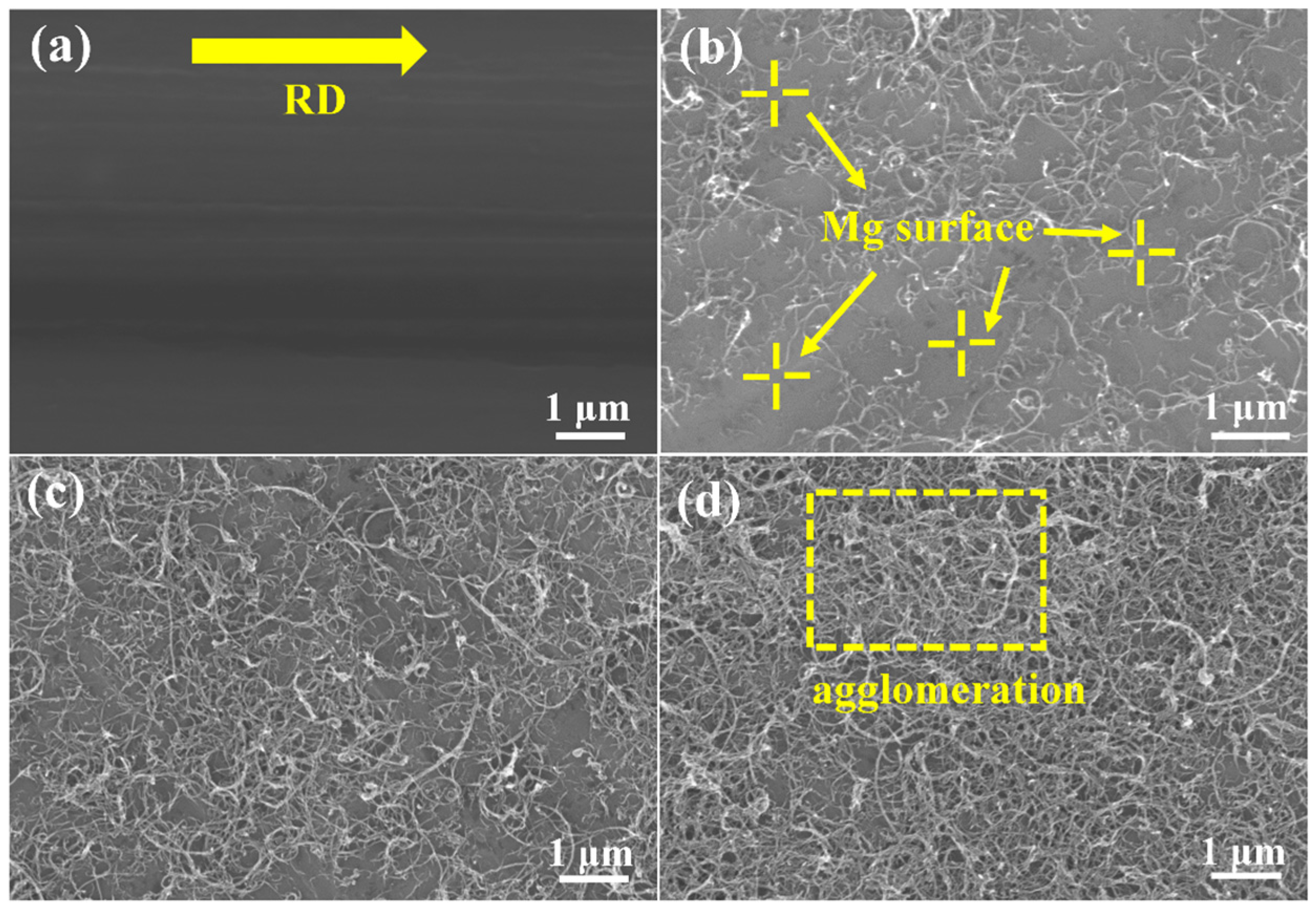
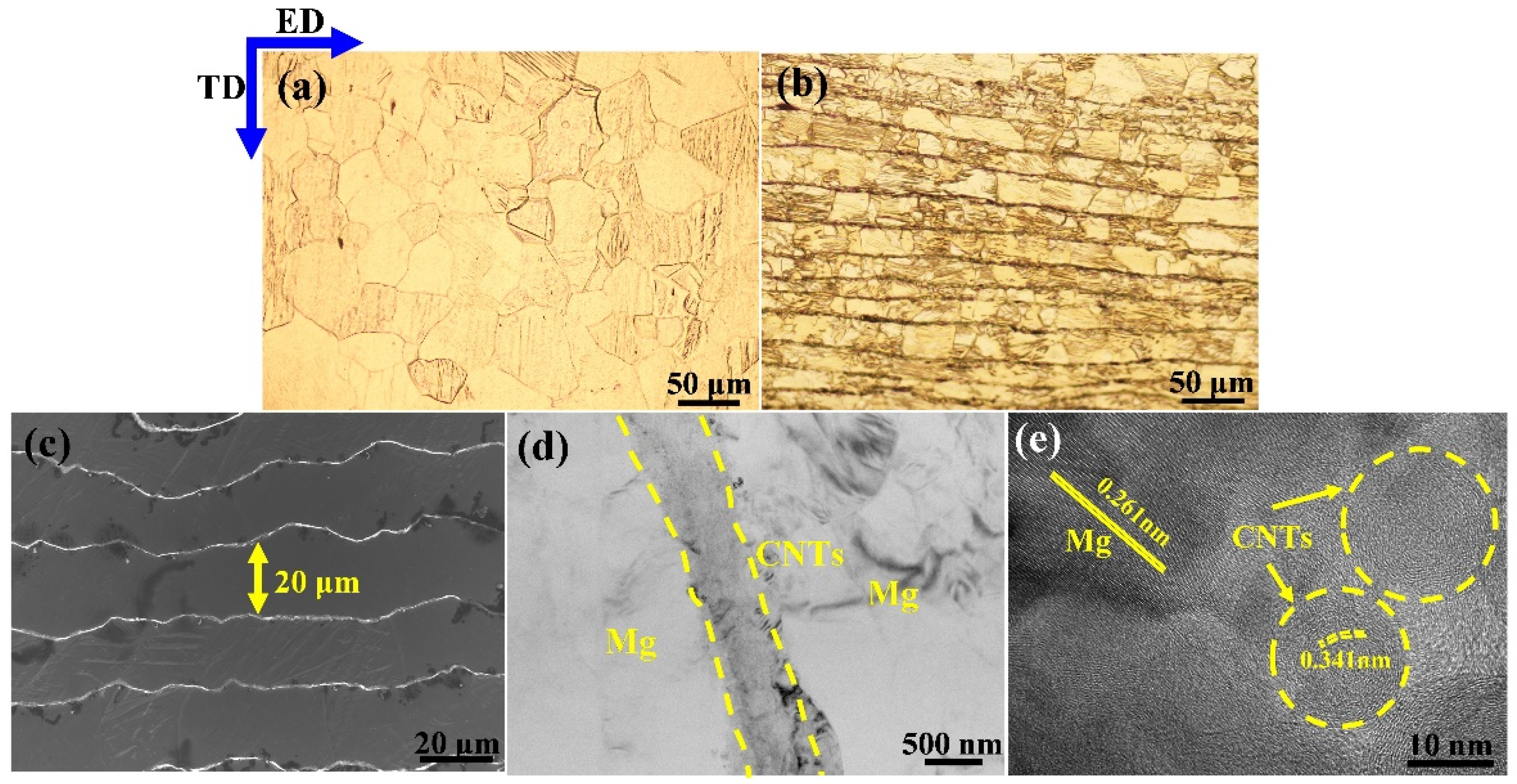
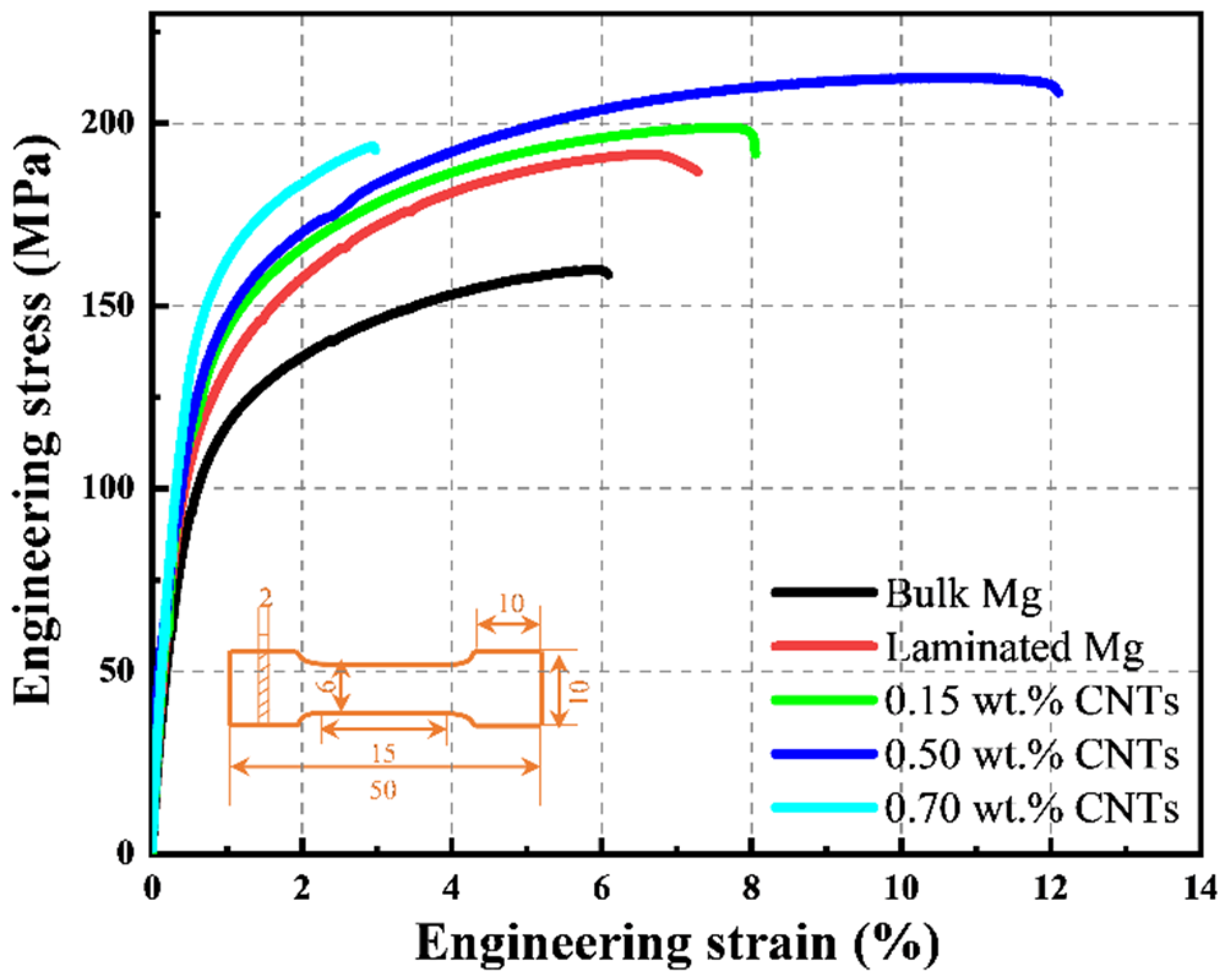
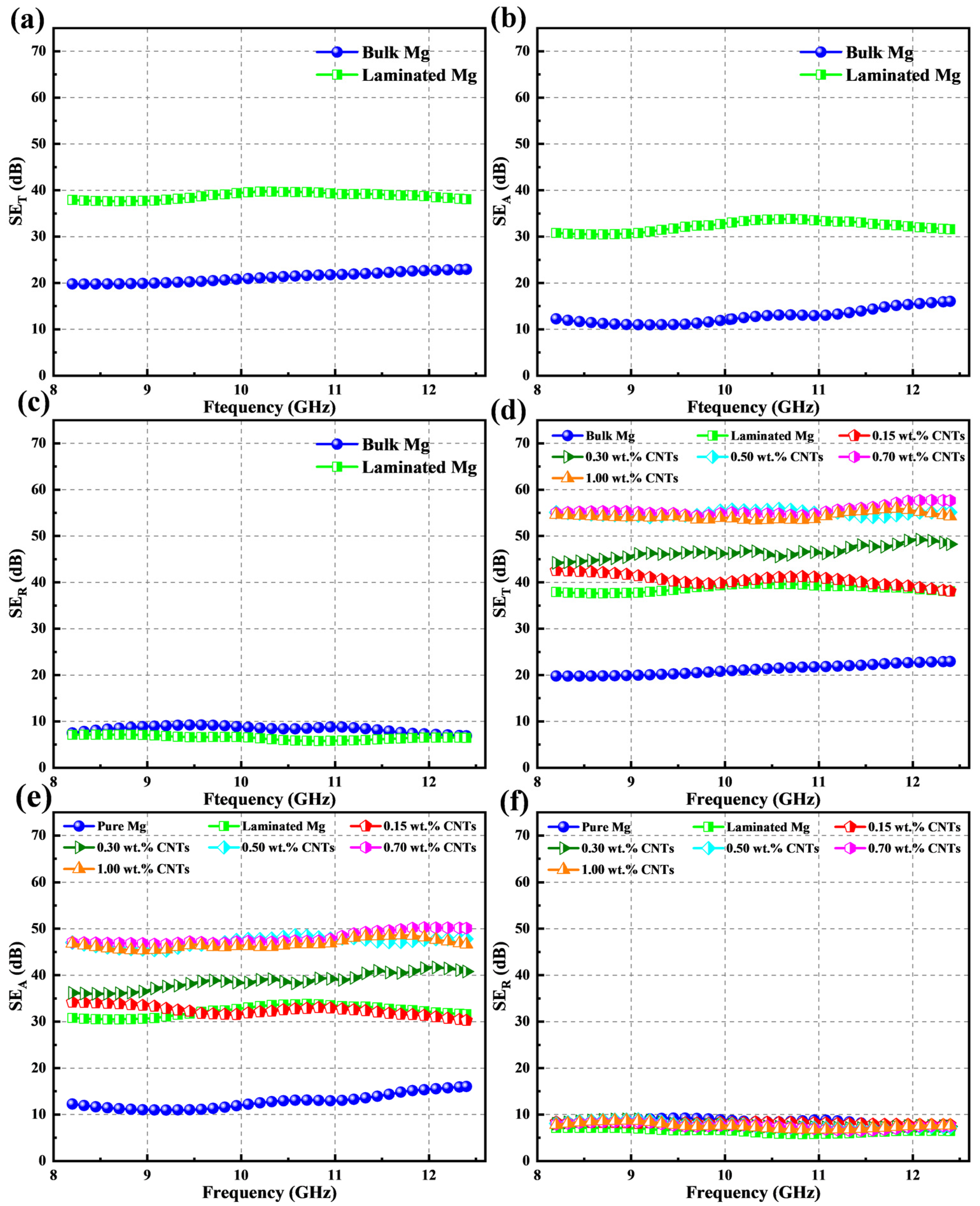


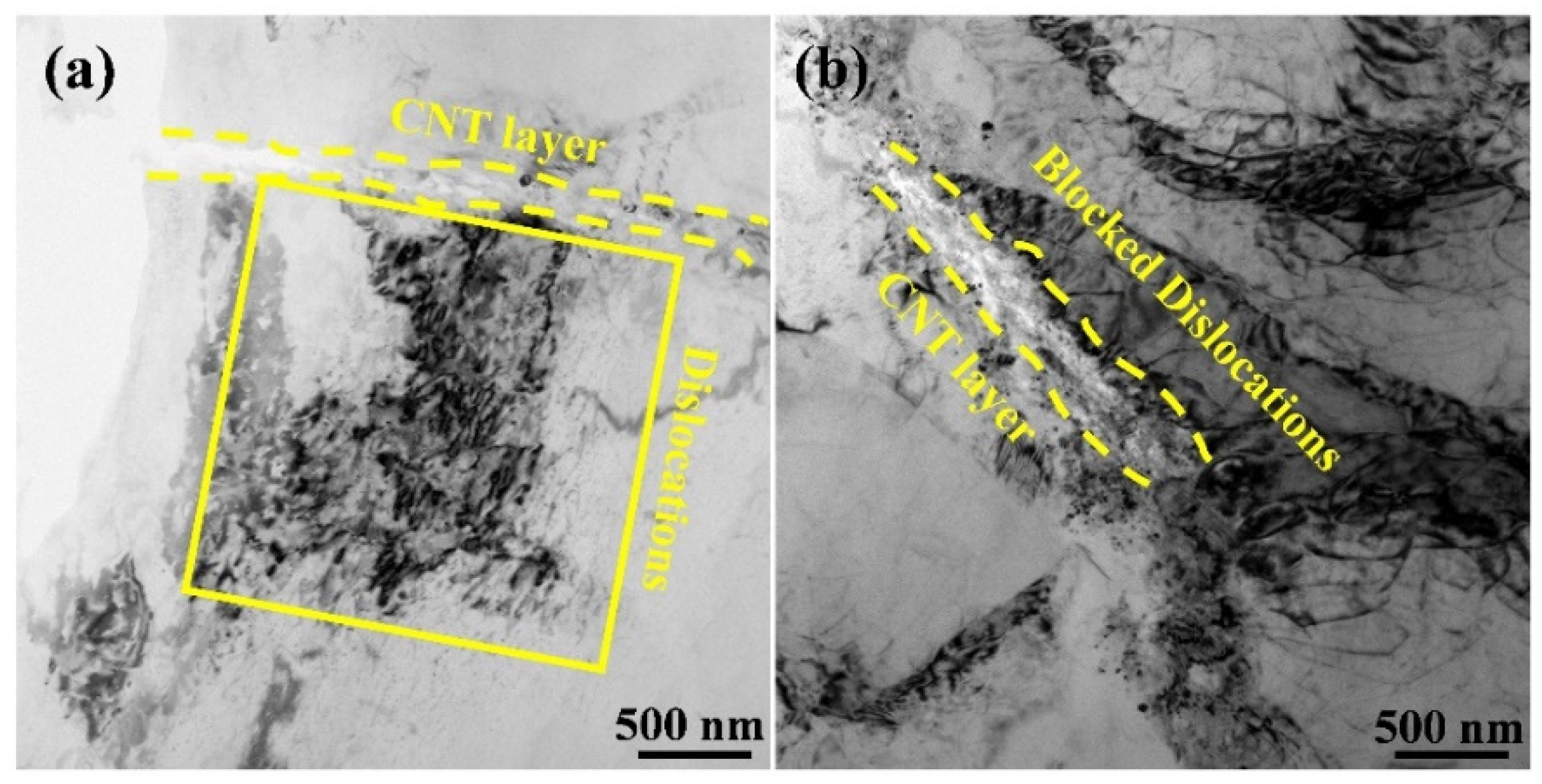


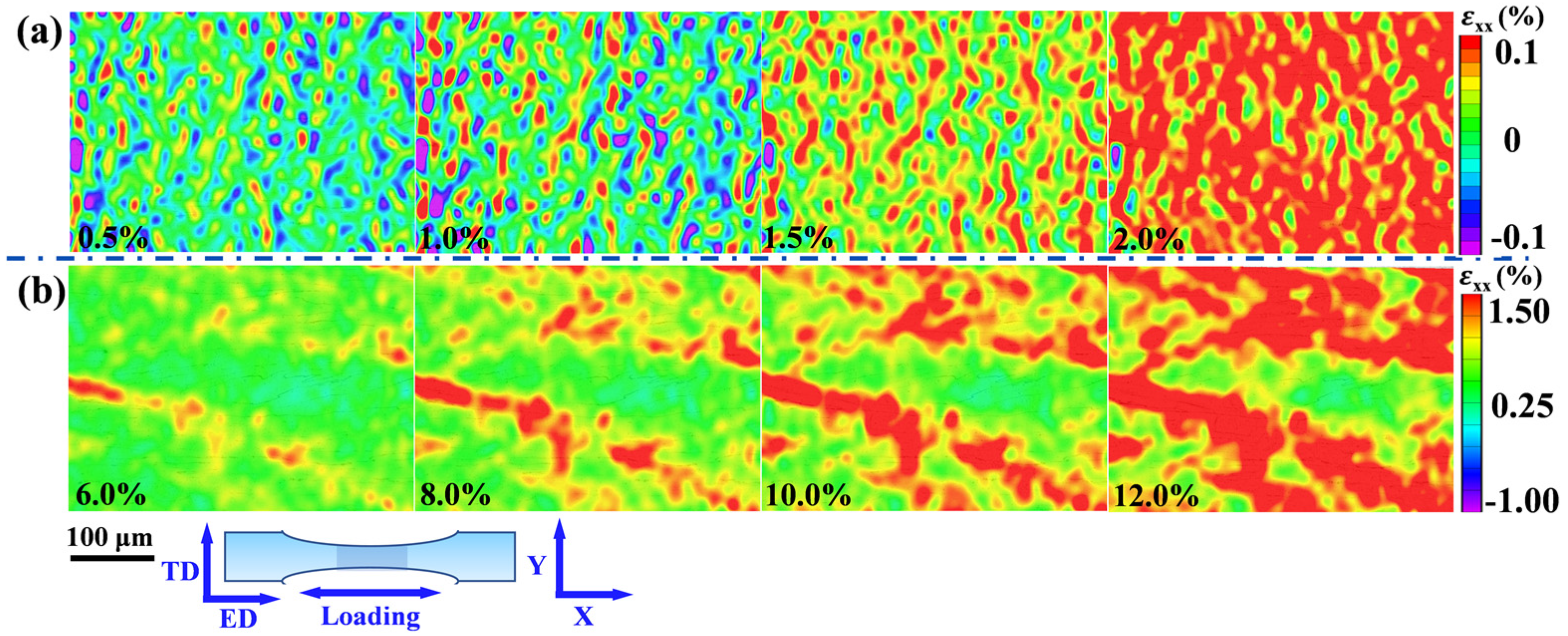
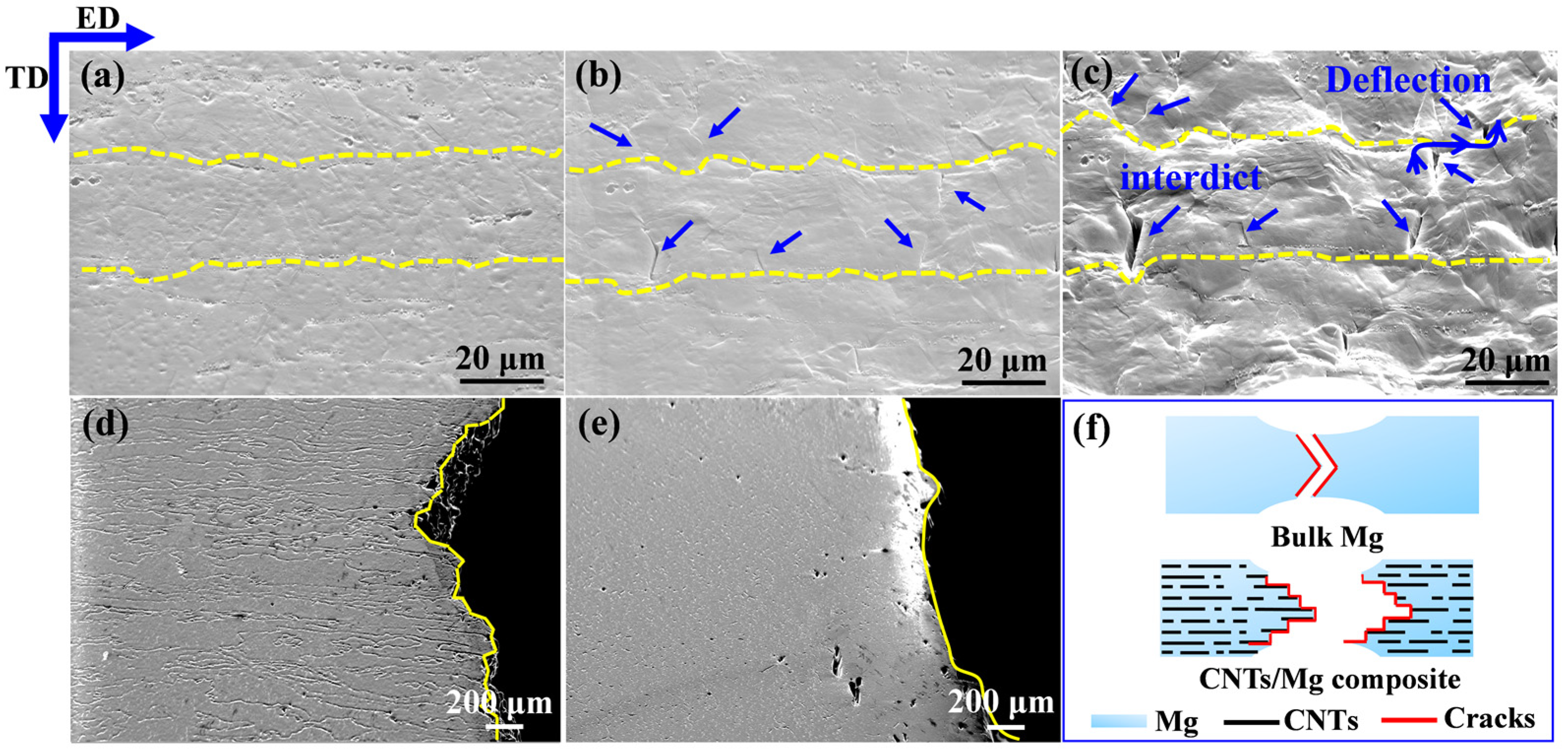
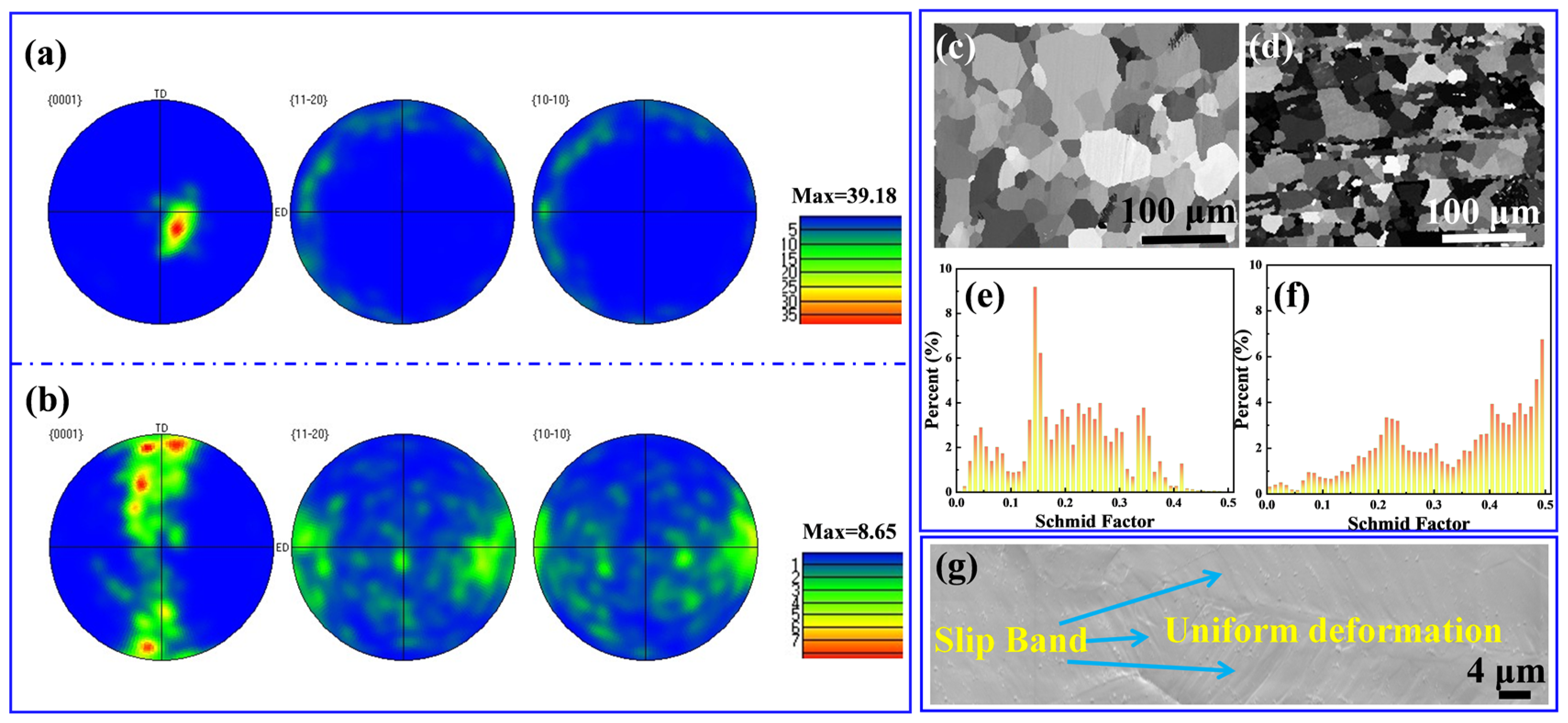
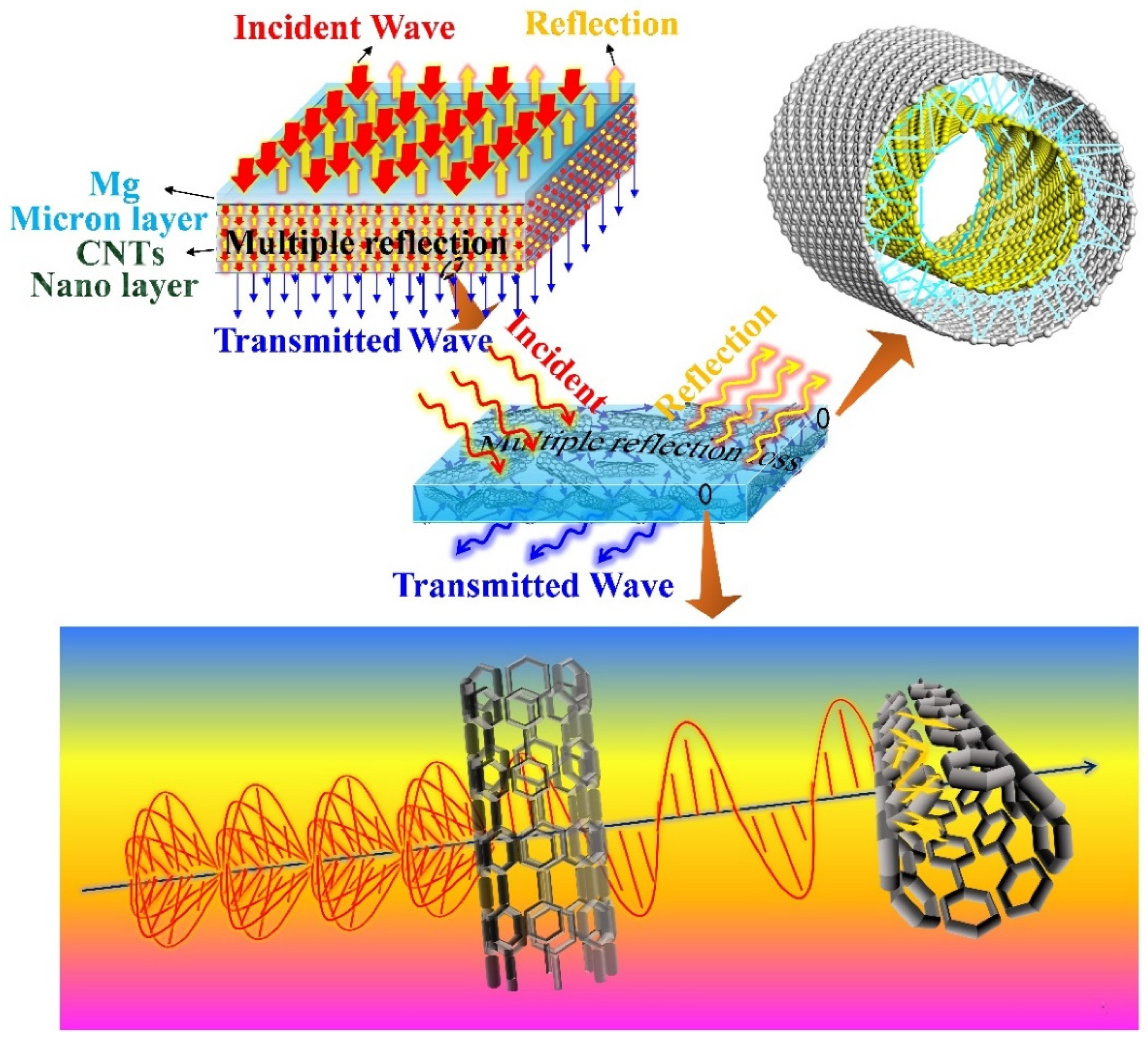
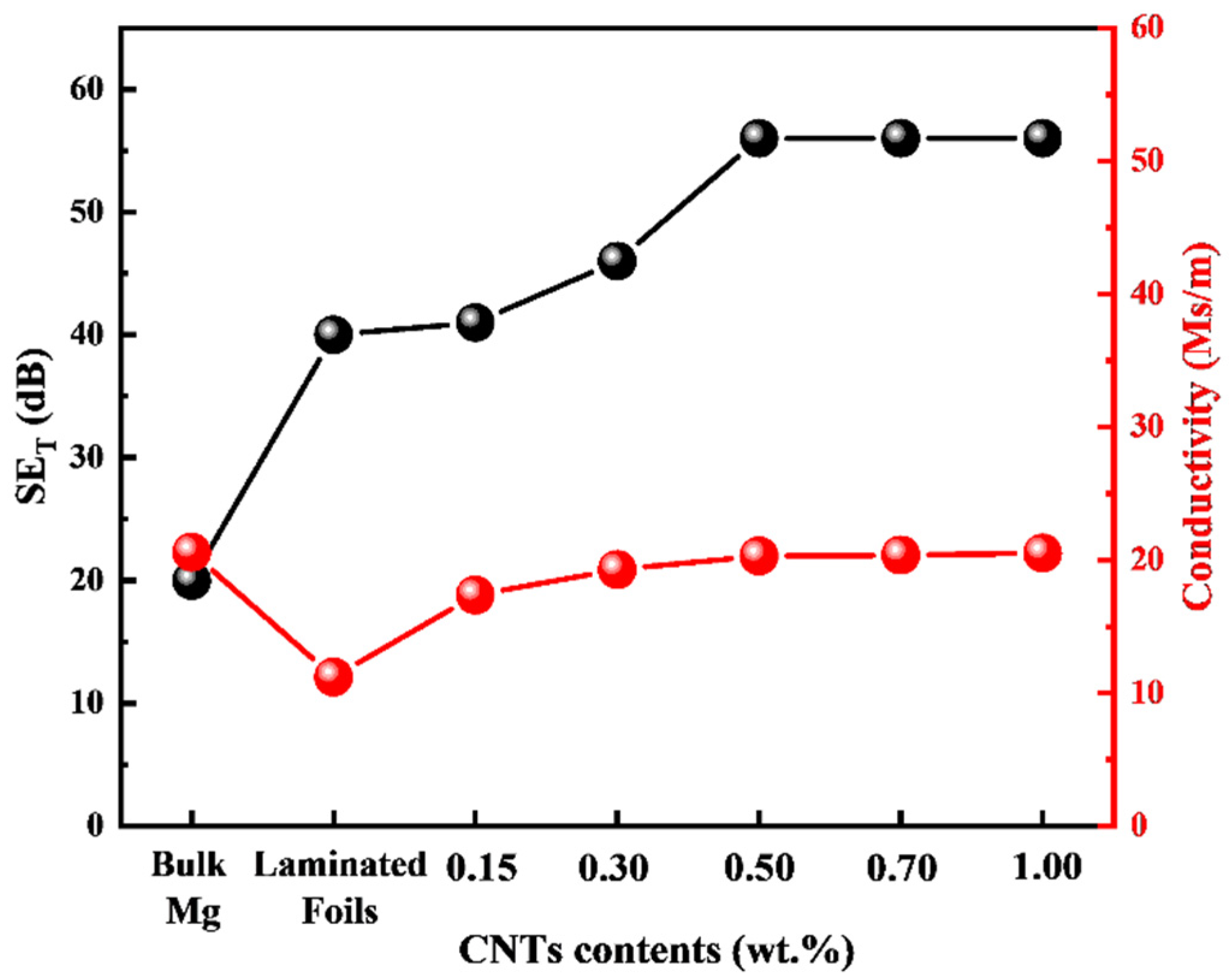
| Alloying Element | Fe | Si | Ni | Cu | Al | Cl | Mn | Ti |
|---|---|---|---|---|---|---|---|---|
| Content (%) | 0.004 | 0.005 | 0.0007 | 0.003 | 0.006 | 0.003 | 0.01 | 0.014 |
| Materials | YS (MPa) | UTS (MPa) | Elongation (%) |
|---|---|---|---|
| Bulk Mg | 88 | 159 | 6.1 |
| Laminated Mg | 102 | 185 | 7.3 |
| 0.15 wt.% CNTs/Mg | 119 | 198 | 8.0 |
| 0.50 wt.% CNTs/Mg | 130 | 213 | 12.1 |
| 0.70 wt.% CNTs/Mg | 137 | 192 | 3.2 |
Publisher’s Note: MDPI stays neutral with regard to jurisdictional claims in published maps and institutional affiliations. |
© 2021 by the authors. Licensee MDPI, Basel, Switzerland. This article is an open access article distributed under the terms and conditions of the Creative Commons Attribution (CC BY) license (https://creativecommons.org/licenses/by/4.0/).
Share and Cite
Sun, Z.; Shi, H.; Hu, X.; Yan, M.; Wang, X. Synergistic Strengthening of Mechanical Properties and Electromagnetic Interference Shielding Performance of Carbon Nanotubes (CNTs) Reinforced Magnesium Matrix Composites by CNTs Induced Laminated Structure. Materials 2022, 15, 300. https://doi.org/10.3390/ma15010300
Sun Z, Shi H, Hu X, Yan M, Wang X. Synergistic Strengthening of Mechanical Properties and Electromagnetic Interference Shielding Performance of Carbon Nanotubes (CNTs) Reinforced Magnesium Matrix Composites by CNTs Induced Laminated Structure. Materials. 2022; 15(1):300. https://doi.org/10.3390/ma15010300
Chicago/Turabian StyleSun, Zhenming, Hailong Shi, Xiaoshi Hu, Mufu Yan, and Xiaojun Wang. 2022. "Synergistic Strengthening of Mechanical Properties and Electromagnetic Interference Shielding Performance of Carbon Nanotubes (CNTs) Reinforced Magnesium Matrix Composites by CNTs Induced Laminated Structure" Materials 15, no. 1: 300. https://doi.org/10.3390/ma15010300
APA StyleSun, Z., Shi, H., Hu, X., Yan, M., & Wang, X. (2022). Synergistic Strengthening of Mechanical Properties and Electromagnetic Interference Shielding Performance of Carbon Nanotubes (CNTs) Reinforced Magnesium Matrix Composites by CNTs Induced Laminated Structure. Materials, 15(1), 300. https://doi.org/10.3390/ma15010300








